Posted by: Northwest Eye in General on August 18, 2025
Overview
Ischemic optic neuropathy is a condition that can lead to sudden vision loss, often stemming from insufficient blood flow to the optic nerve. There are two main types: arteritic (AAION) and non-arteritic (NAION).
We understand that facing such a diagnosis can be overwhelming, and it’s essential to recognize the symptoms and risk factors early on. Timely intervention, especially for AAION, can significantly improve outcomes. For NAION, managing underlying conditions is crucial, as there are currently no proven treatments to restore vision.
It’s common to feel anxious about your health, but please know that you are not alone. Early recognition of symptoms can make a difference, and we are here to help you through this process. If you have any concerns, don’t hesitate to reach out to a healthcare professional who can guide you with compassion and expertise.
Introduction
Ischemic optic neuropathy (ION) is a critical condition that can lead to sudden vision loss due to inadequate blood flow to the optic nerve. We understand that this diagnosis can be frightening, and it’s essential to grasp this complex disorder. ION encompasses two primary types—Arteritic and Non-Arteritic Anterior Ischemic Optic Neuropathy—each with distinct causes and treatment approaches. Recognizing the symptoms early can be challenging, especially when considering the myriad of risk factors, from age and vascular conditions to lifestyle choices.
It’s common to feel overwhelmed by the information, but empowering yourself with knowledge and resources is vital. How can you effectively manage this potentially sight-threatening condition? We are here to help you through this process, providing support and guidance every step of the way.
Define Ischemic Optic Neuropathy and Its Types
Ischemic optic neuropathy is a condition that can result in sudden loss of sight caused by insufficient blood flow to the optic nerve. We understand that this diagnosis can be alarming, and it’s important to know that there are two primary types of ION:
-
Arteritic Anterior Ischemic Optic Neuropathy (AAION): This type is linked to inflammation of the arteries, often associated with giant cell arteritis. It typically presents with severe symptoms, and we urge you to seek immediate medical attention. High-dose intravenous methylprednisolone may be necessary in acute cases to prevent irreversible damage.
-
Non-Arteritic Anterior Ischemic Optic Neuropathy (NAION): This is the more common form, occurring without inflammation. It is frequently associated with vascular factors such as hypertension and diabetes. NAION usually presents with painless vision loss and is more prevalent in individuals over 50 years of age. The annual incidence ranges from 2.3 to 10.2 per 100,000 individuals in this demographic. Recent studies have also indicated a significant association between NAION and obstructive sleep apnea (OSA), which may exacerbate vascular dysregulation.
Understanding these distinctions is vital for the appropriate diagnosis and management of ischemic optic neuropathy. Case studies have shown that timely intervention in AAION can significantly improve outcomes. It’s reassuring to note that NAION may exhibit spontaneous visual improvement in approximately 40% of cases. However, treatment options for NAION remain largely empirical, with most lacking robust clinical evidence. Furthermore, it’s essential to consider the potential risks associated with semaglutide, as it has been recognized as an extremely rare side effect of this medication, impacting up to 1 in 10,000 users. As noted by experts, distinguishing between these types is crucial for implementing appropriate therapeutic strategies. We are here to help you through this process, ensuring you receive the care and support you need.
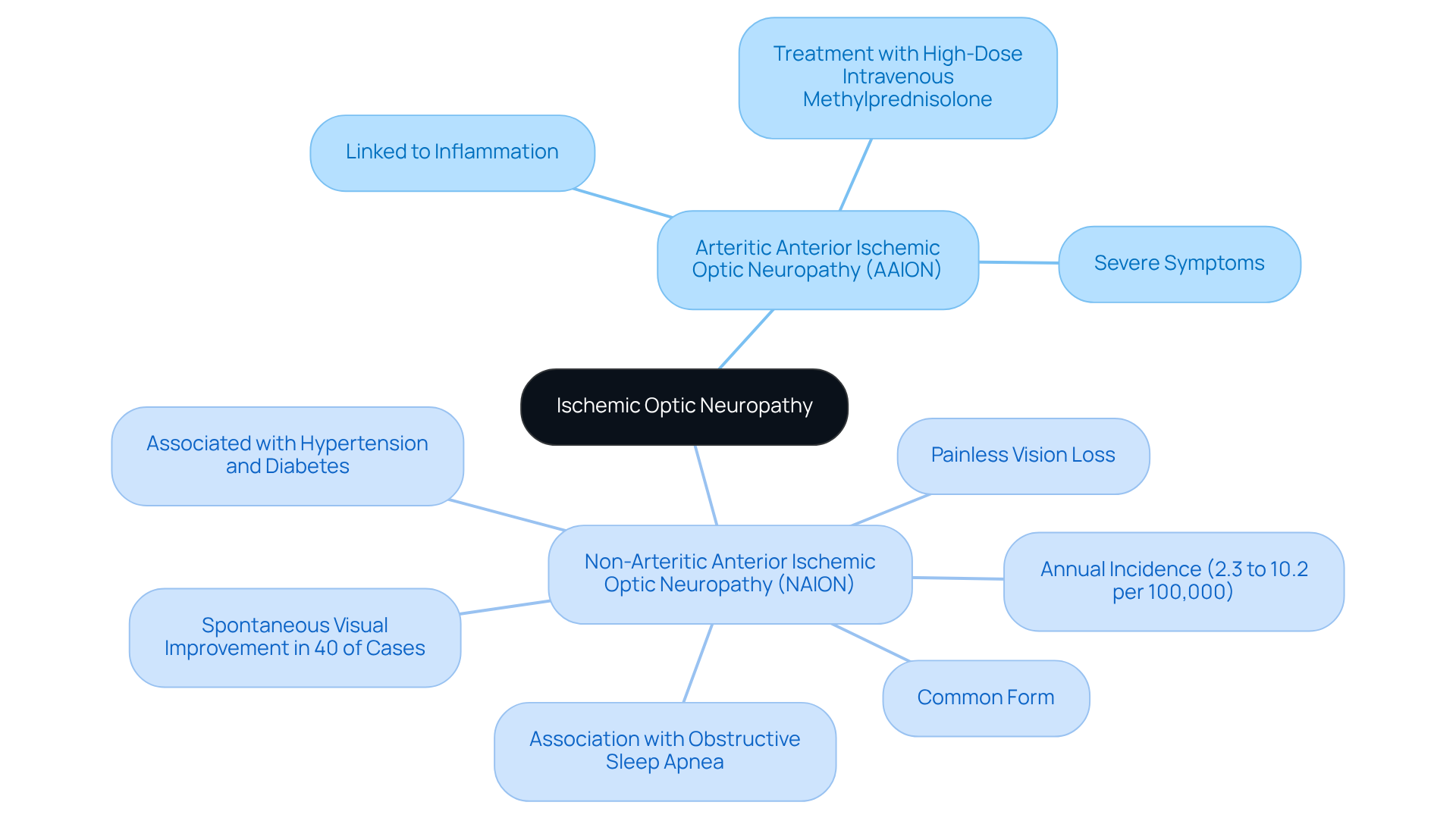
Explore Causes and Risk Factors
Ischemic optic neuropathy is a concerning diagnosis that can arise from a combination of vascular and non-vascular factors. Understanding the key risk factors can help you feel more informed and prepared.
-
Age: If you’re over 50, it’s important to know that the risk of developing ischemic optic neuropathy significantly increases. In the U.S., the prevalence ranges from 2.3 to 10.3 cases per 100,000 people, translating to approximately 6,000 new cases annually.
-
Vascular Conditions: Conditions like hypertension and diabetes can significantly affect blood flow to your optic nerve. Recent studies have highlighted the strong connection between diabetes and optic nerve disorders, underscoring the need for careful monitoring if you have diabetes.
-
Lifestyle Factors: Choices such as smoking and obesity can further increase your likelihood of developing ischemic optic neuropathy (ION). These factors may worsen underlying vascular conditions, making you more susceptible.
-
Sleep Apnea: If you have untreated obstructive sleep apnea, it’s vital to be aware that it has been associated with over a six-fold increased risk of NAION, particularly in high-altitude areas where oxygen levels are lower.
-
Medications: Some medications, especially those affecting blood pressure, might elevate the likelihood of ischemic optic neuropathy. Notably, recent studies suggest that treatments like semaglutide or tirzepatide could be linked to a higher chance of NAION, which means closer observation is essential if you are on these medications.
We understand that comprehending these risk factors is essential for early identification and effective management. This knowledge enables prompt intervention, which can be crucial in preserving your sight. Remember, we are here to help you through this process and provide support every step of the way.
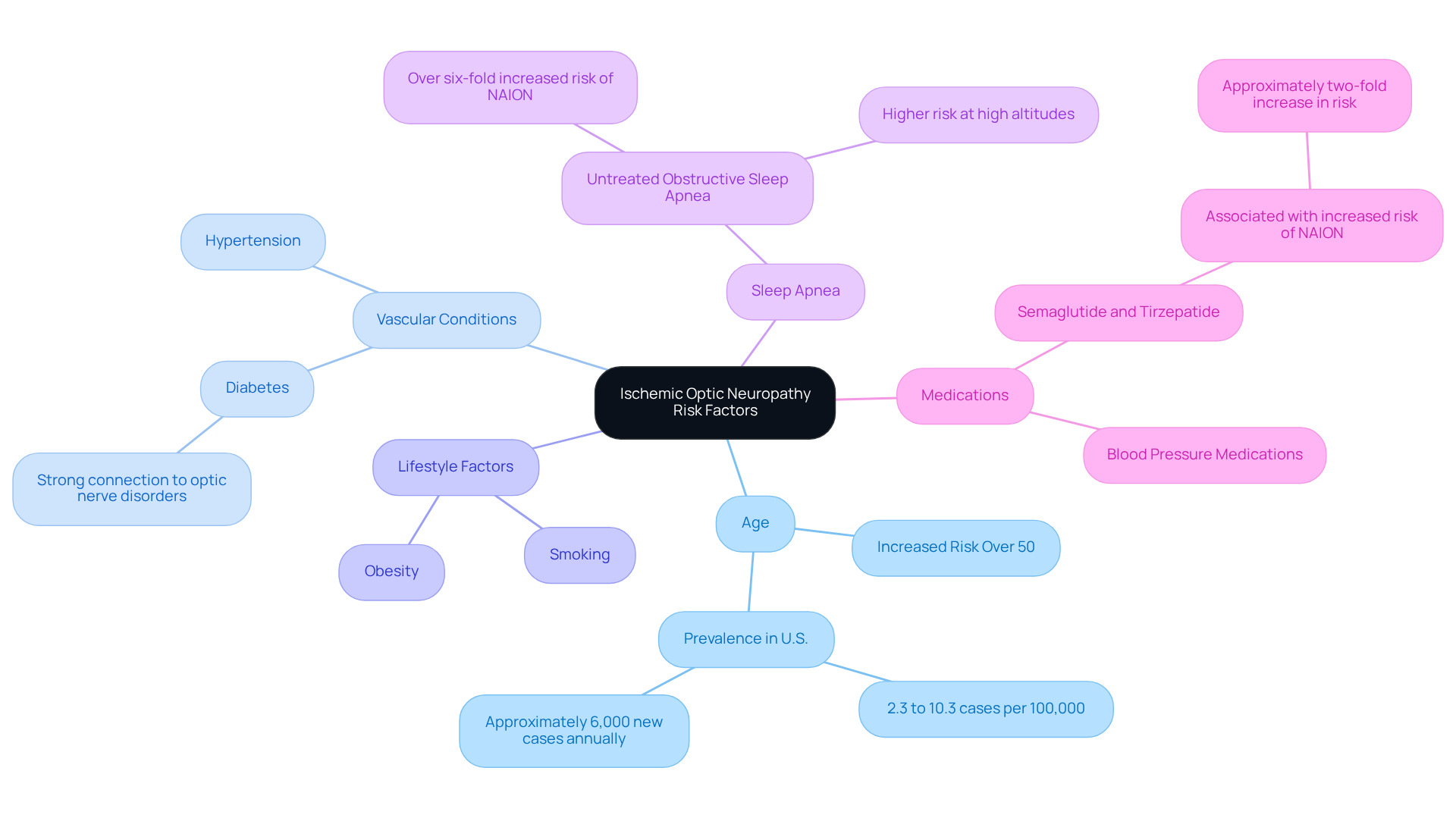
Identify Symptoms and Early Warning Signs
Symptoms of ischemic optic neuropathy (ION) can vary by type, but we recognize that being aware of them can be concerning. Here are the typical symptoms you might encounter:
- Sudden Vision Loss: This can be alarming, as it often occurs rapidly over minutes to hours, signaling a potential emergency.
- Painless Sight Changes: Unlike many other eye conditions, the loss of sight associated with ischemic optic neuropathy (ION) is generally painless. This can lead to underestimating its severity, and we want to assure you that your concerns are valid.
- Visual Field Defects: You may notice a loss of peripheral sight or develop a central scotoma, resulting in a blind spot in your central vision.
- Transient Visual Disturbances: Some individuals report temporary episodes of blurred sight prior to more permanent loss, serving as an early warning sign.
Recognizing these symptoms promptly is essential for effective management. We understand that timely intervention can significantly improve visual outcomes. Statistics suggest that abrupt loss of sight can impact people over the age of 50, with males and Caucasians at a greater likelihood of developing ischemic optic neuropathy. Additionally, vascular risk factors such as high blood pressure, diabetes, and high cholesterol can further increase this likelihood.
Your experiences matter, and we emphasize the importance of consulting with eye care experts upon observing any alterations in sight. Remember, minutes can make a crucial difference in treatment effectiveness. As the Cleveland Clinic states, ‘Acting quickly could make all the difference and help shield you from more serious sight disruptions and difficulties.’ We are here to help you through this process.
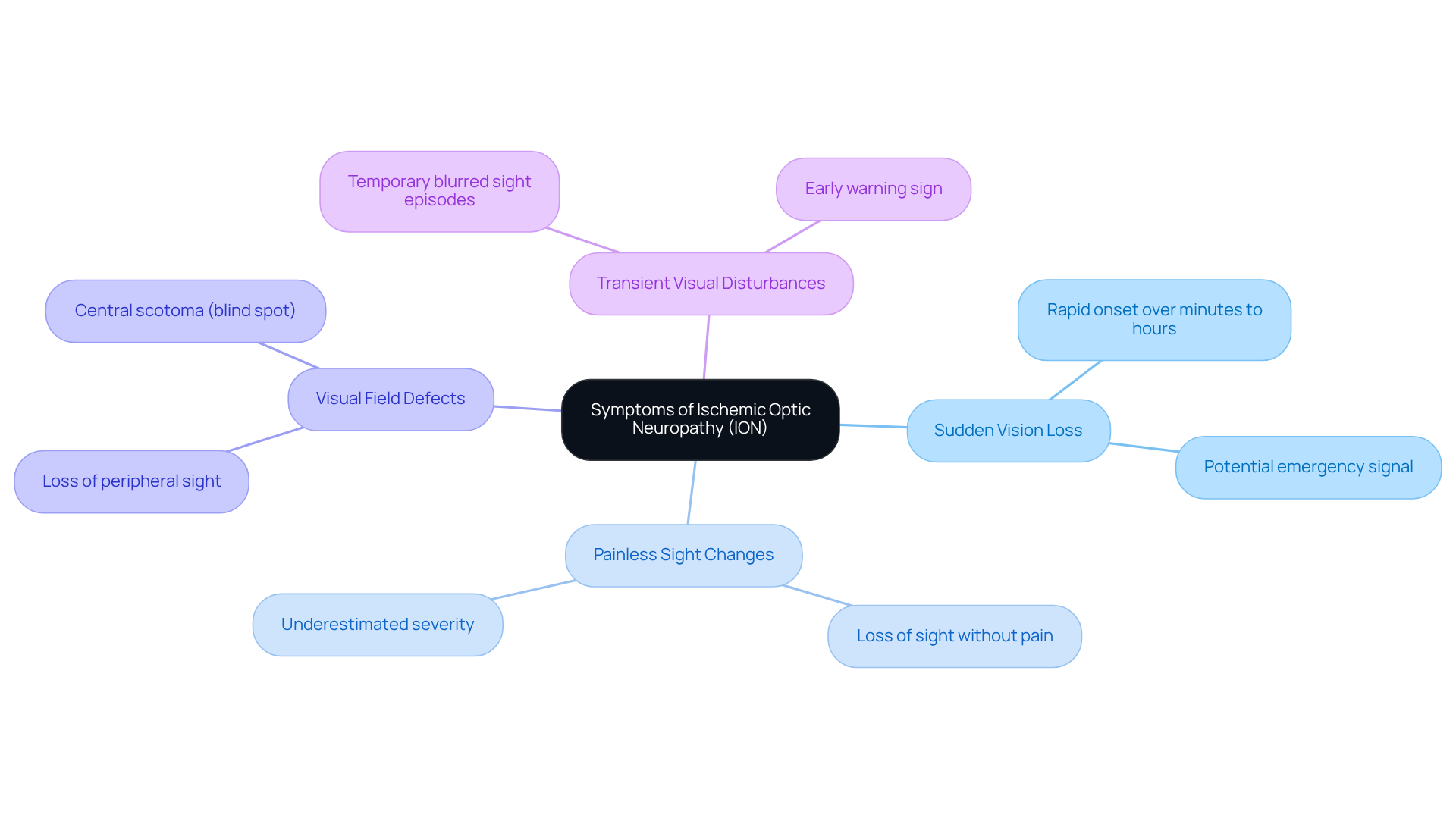
Review Treatment Options and Management Strategies
Treatment for ischemic optic neuropathy is personalized, considering the specific type and underlying causes.
For ischemic optic neuropathy, specifically Arteritic Anterior Ischemic Optic Neuropathy (AAION), we understand how concerning this diagnosis can be. Immediate intervention with high-dose corticosteroids, such as prednisone, is crucial to prevent further vision loss. This approach is particularly vital for individuals with giant cell arteritis, as prompt corticosteroid therapy can significantly reduce the chances of losing sight in the unaffected eye. Often, a temporal artery biopsy is performed to confirm the diagnosis of AAION, which is essential for initiating the right treatment.
For ischemic optic neuropathy, particularly Non-Arteritic Anterior Ischemic Optic Neuropathy (NAION), it’s common to feel anxious when facing this condition, especially since there is currently no proven treatment to restore lost vision. However, managing underlying factors—like hypertension and diabetes—is essential. Some studies suggest that antiplatelet drugs, such as aspirin, may help lower the risk of future episodes, although their effectiveness is still being studied.
Surgical Options: In some cases, surgical procedures, like nerve sheath decompression, may be considered to relieve pressure and improve blood flow if structural issues are identified. It’s important to be aware that this procedure carries risks, including infection and potential further vision loss.
Regular follow-up with an ophthalmologist is crucial for monitoring your condition and adjusting treatment plans as needed. Imaging methods, such as Optical Coherence Tomography (OCT), can also aid in evaluating the nerve and guiding management choices. Remember, early detection and intervention are linked to better outcomes. This highlights the importance of proactive eye care and managing systemic health issues. We are here to help you through this process.
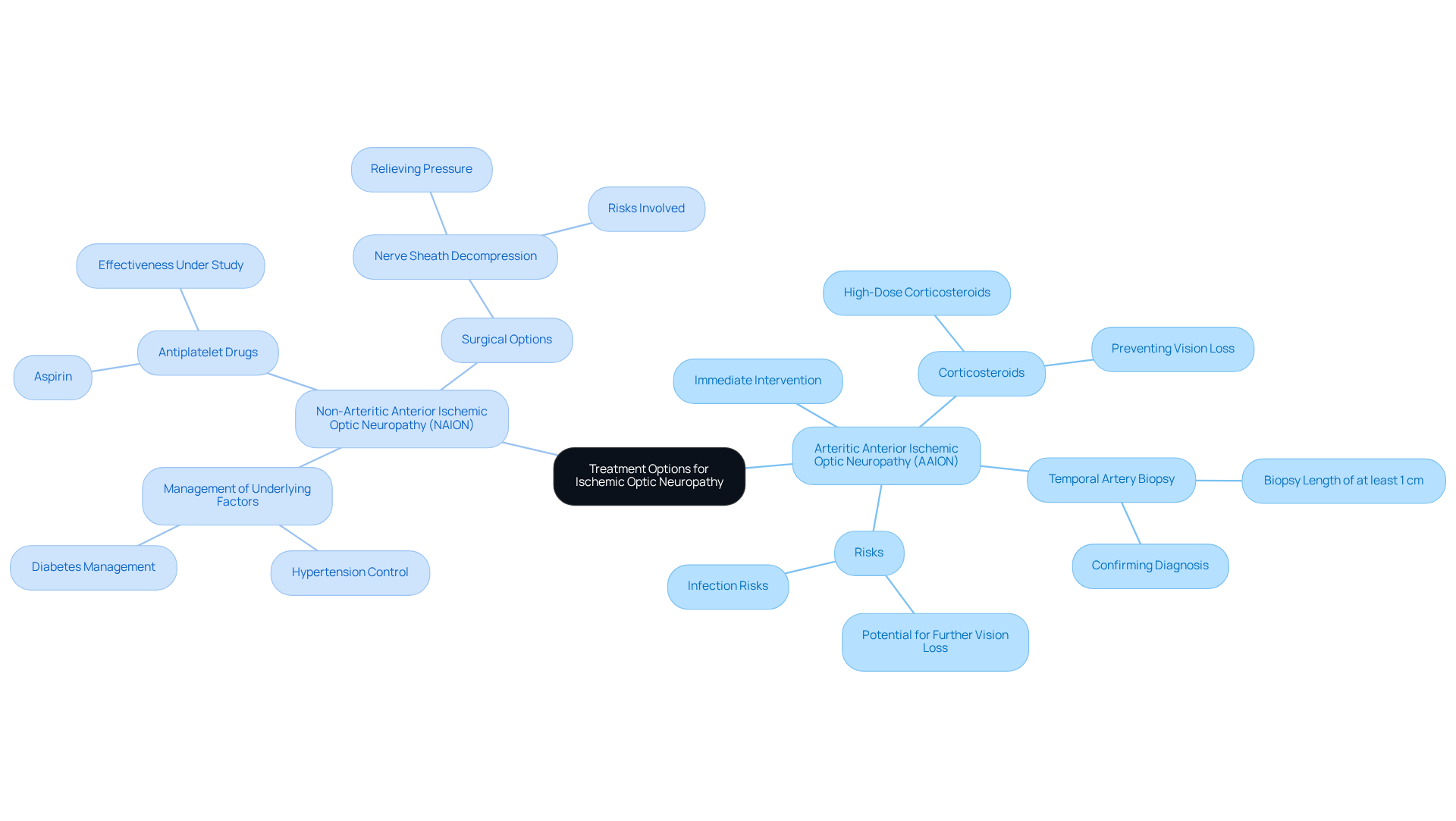
Emphasize Patient Education and Support Resources
Effective management of ischemic optic neuropathy relies heavily on robust patient education and support resources. We understand that navigating this condition can be challenging, and we are here to help you through this process. Key components include:
- Educational Materials: Comprehensive brochures and online resources that detail ION, its symptoms, and management strategies are essential for your understanding.
- Support Groups: Engaging with support groups allows you to connect with others who have faced similar challenges. This can offer emotional support and practical advice that is invaluable during recovery.
- Regular Check-ups: Consistent follow-up appointments with eye care providers are crucial for monitoring your condition and making necessary adjustments to treatment plans. This proactive approach can significantly impact your outcomes, as timely interventions can prevent further vision loss.
- Lifestyle Modifications: We encourage you to adopt healthier lifestyle choices, such as improved diet, regular exercise, and smoking cessation, to mitigate risk factors associated with ischemic optic neuropathy. Chronic conditions like high blood pressure and diabetes are recognized factors in nerve health, making these changes essential.
Statistics indicate that around 40% of individuals with significant visual acuity loss from ischemic optic neuropathy, specifically non-arteritic anterior ischemic optic neuropathy (NAION), may experience some improvement in their central vision over time. This underscores the importance of utilizing available resources and maintaining an active role in your eye health. By leveraging these educational and support resources, you can enhance your quality of life and navigate the complexities of your condition more effectively.
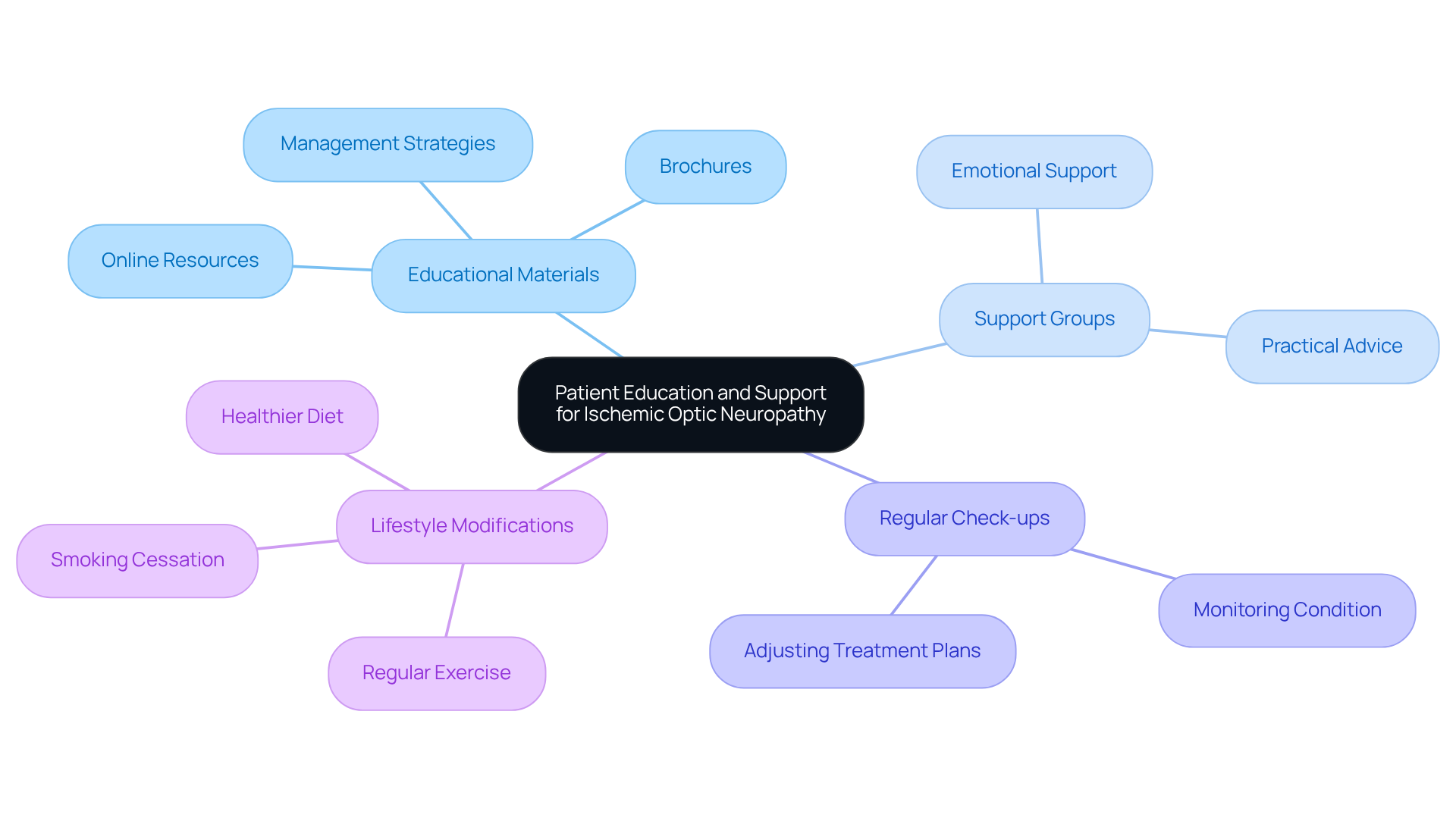
Conclusion
Ischemic optic neuropathy (ION) is a significant concern for those experiencing sudden vision loss due to inadequate blood flow to the optic nerve. We understand that this can be a distressing experience. Therefore, recognizing the two primary types—Arteritic Anterior Ischemic Optic Neuropathy (AAION) and Non-Arteritic Anterior Ischemic Optic Neuropathy (NAION)—is crucial for effective diagnosis and management. The urgency of seeking medical attention, particularly for AAION, cannot be overstated. Timely intervention can prevent irreversible damage and improve outcomes.
Throughout this discussion, we have highlighted key insights, including the risk factors associated with ION, such as:
- Age
- Vascular conditions
- Lifestyle choices
It’s common to feel uncertain, but recognizing symptoms like sudden vision loss and transient visual disturbances can facilitate early intervention. Treatment strategies vary between the two types; AAION requires immediate corticosteroid therapy, while NAION focuses on managing underlying health issues. Additionally, we emphasize the importance of patient education and support resources as vital components in navigating this complex condition.
Ultimately, awareness and proactive management of ischemic optic neuropathy can significantly enhance quality of life and preserve vision. We encourage you to stay informed about your health, engage with healthcare providers, and utilize available educational materials and support networks. By taking these steps, the risks associated with ION can be mitigated, paving the way toward better eye health. Remember, we are here to help you through this process.
Frequently Asked Questions
What is ischemic optic neuropathy (ION)?
Ischemic optic neuropathy is a condition characterized by sudden loss of sight due to insufficient blood flow to the optic nerve.
What are the two primary types of ischemic optic neuropathy?
The two primary types are Arteritic Anterior Ischemic Optic Neuropathy (AAION), which is linked to inflammation of the arteries, and Non-Arteritic Anterior Ischemic Optic Neuropathy (NAION), which occurs without inflammation.
What are the symptoms of Arteritic Anterior Ischemic Optic Neuropathy (AAION)?
AAION typically presents with severe symptoms and is often associated with giant cell arteritis. Immediate medical attention is crucial.
What treatment is recommended for AAION?
High-dose intravenous methylprednisolone may be necessary in acute cases of AAION to prevent irreversible damage.
How common is Non-Arteritic Anterior Ischemic Optic Neuropathy (NAION)?
NAION is the more common form of ION, frequently associated with vascular factors such as hypertension and diabetes, and it usually presents with painless vision loss.
What is the annual incidence of NAION in individuals over 50?
The annual incidence of NAION in individuals over 50 years of age ranges from 2.3 to 10.2 per 100,000 individuals.
What factors are associated with an increased risk of NAION?
NAION has been significantly associated with obstructive sleep apnea (OSA), particularly affecting vascular dysregulation.
Can NAION improve spontaneously?
Yes, approximately 40% of NAION cases may exhibit spontaneous visual improvement.
What are the risk factors for developing ischemic optic neuropathy?
Key risk factors include age (over 50), vascular conditions like hypertension and diabetes, lifestyle factors such as smoking and obesity, untreated obstructive sleep apnea, and certain medications.
How does untreated obstructive sleep apnea affect the risk of NAION?
Untreated obstructive sleep apnea is associated with over a six-fold increased risk of NAION.
Are there any medications linked to an increased risk of NAION?
Yes, some medications, particularly those affecting blood pressure, such as semaglutide and tirzepatide, may elevate the likelihood of NAION.
Why is it important to understand the risk factors for ischemic optic neuropathy?
Understanding the risk factors is essential for early identification and effective management, enabling prompt intervention to preserve sight.






